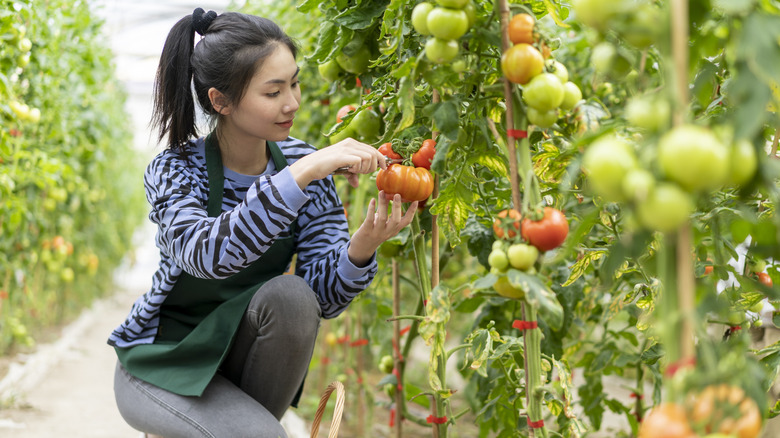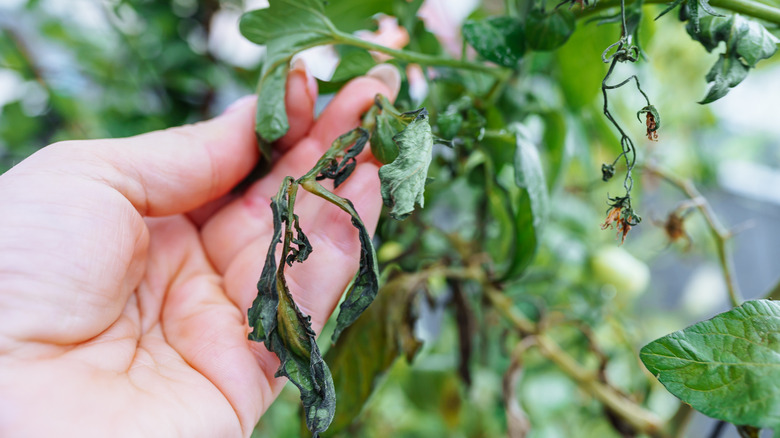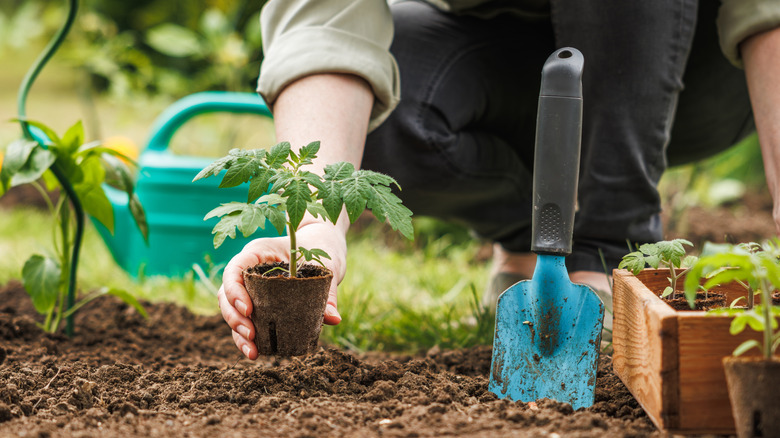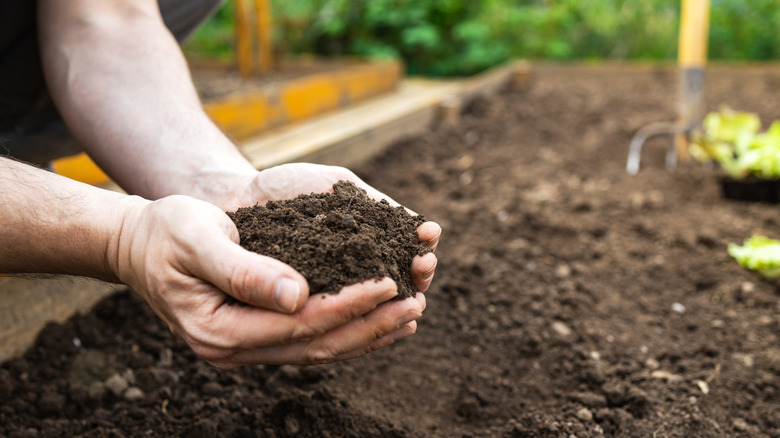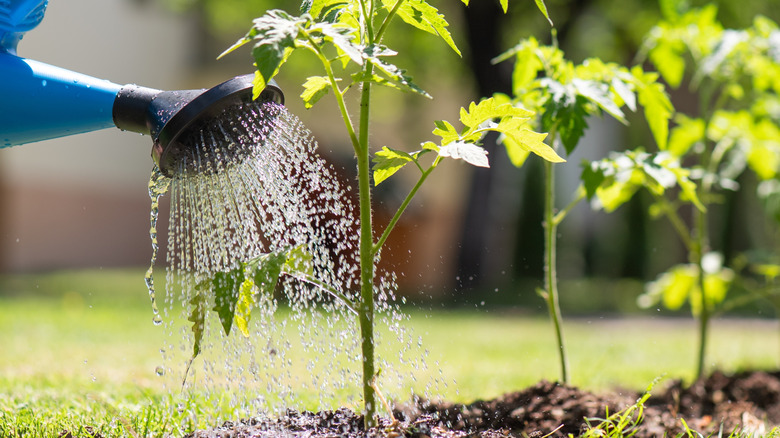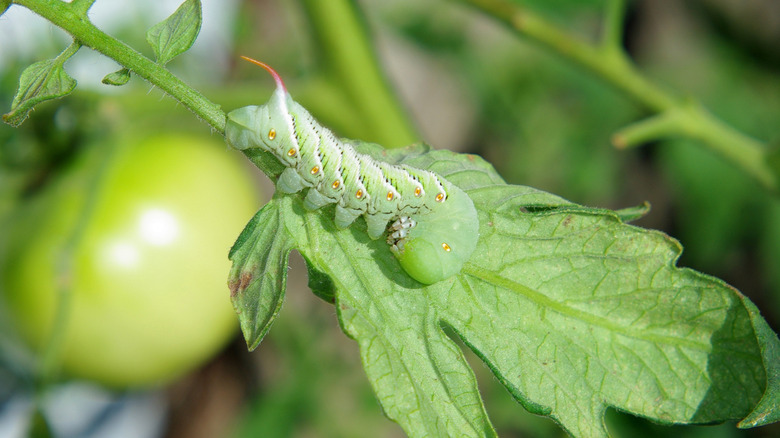The Unexpected Downsides To Growing Tomatoes In Your Garden
Growing your own tomatoes at home can be very rewarding. You can use the fruits — and, yes, tomatoes are fruits — to make everything from sauce, salsa, soup, salads, and more. Tomatoes are often touted as an easy-to-grow plant. However, easy-to-grow does not equal foolproof. It also doesn't mean that there aren't things you'll need to do to make sure that your garden is ready for the plants to thrive and produce the fruit you're looking to enjoy.
Unfortunately, there are a few downsides to growing tomatoes in your garden. These downsides, which can include intense sun, high watering needs, and the risk of damage from various pests, shouldn't necessarily be dealbreakers. You don't have to be scared off from adding tomatoes to your vegetable garden. However, these potential issues are certainly things you'll want to be well-educated about if you want to be prepared and set your plants up to thrive.
Keeping an eye on the weather is crucial
Frost and tomatoes do not mix. If the plants are left outside during a frost, they will likely die. Beyond the colder temperatures that typically cause frost, the plants don't fare well even in cooler temperatures. If the thermometer reads less than 55 degrees Fahrenheit overnight, you may wake up to find that your plants have lost their blossoms. Therefore, if you plan to add a tomato plant to your garden, monitoring the weather will be a crucial part of your task. If there is a frost warning, then you'll want to do what you can to protect the plants. If they're in planters or baskets, bringing them in the house will be the best choice. If your plants are in the ground and cannot be brought in, cover them with old cotton sheets, a cloche cloth, or even cardboard boxes.
In addition to the hassle of watching the weather because of your tomatoes that are already outside, their susceptibility to cold temperatures can also make growing the plants from seeds a bit more complex. You'll need to look up the average final frost date for your area, calculate the date that is about six weeks before that, and then start the seeds indoors. Before transporting them outside full time, you'll also want to harden them off by exposing them to outdoor conditions for increasingly long periods of time over about a week. Be extra cautious to confirm that there are no upcoming frost warnings before you actually move them outdoors permanently.
Choosing a spot for tomatoes in your garden can be difficult
You can't simply plop your tomato plants into any old spot in your garden and expect them to thrive, as they have some specific care needs. One thing that tomatoes need to thrive is a lot of sunlight. So, when you're considering the best spot in your vegetable garden to plant tomatoes, you'll need to choose one that receives a minimum of 6 hours of full sun (though the plants will do even better when they're able to get between 8 and 10 hours of full sun). If your existing vegetable garden is partially shaded, then you'll need to seek out a sunnier spot in your yard and convert it to a tomato garden if you want the plants to grow properly.
The sunlight needs of the plants aren't the only thing that can make it difficult when selecting a location for your garden. You will need a large enough space to fit the number of tomato plants you wish to grow. However, you cannot simply cram as many plants as will fit into any area. Tomatoes need to be well spaced out to provide adequate airflow between plants. While the spacing needs can vary based on the variety and how you're growing the plant, there are some general recommendations to keep in mind. Rows should be at least 3 feet apart, and the plants themselves should be between 1 ½ and 3 feet apart (with tomato plants on stakes being closer together than those that will be left to grow outwards).
Your garden soil may not meet their needs
Once you've selected a good spot for your garden, you can't assume that the ground is ready for you to transplant the tomatoes. It is unlikely that you already have the ideal soil type for growing healthy garden tomatoes. If you really want to give your plants the best shot at success, you will want to make sure that the pH, nutrients, and drainage of the soil are just right for the tomatoes. The ideal pH for tomatoes is between 6.2 and 6.8. Using a soil test kit to check the pH of your soil, and then amending it with some sulphur or aluminum sulphate if the pH is too basic, can help.
Beyond the pH, it is also important to ensure that there is sufficient nitrogen, phosphorus, and potassium in the soil, especially as the plants are starting to develop. Many experts recommend opting for an all-purpose fertilizer with a 10-10-10 formulation and adding it to the soil before planting your tomatoes.
Finally, don't overlook the importance of ensuring that your soil is well-drained to prevent too much moisture pooling around the roots and potentially causing root rot. You can enrich your current soil and improve its drainage by amending it with some compost, shredded leaves, or other organic matter.
Staying on top of watering can be challenging
Knowing how to properly water your tomatoes is essential. If the plants don't get enough water — or get too much water — it can cause serious issues. Some of these problems can include root rot, wilting leaves, decreased fruit production, diseases, nutritional deficiencies, and more.
As a tomato gardener, you'll need to water the plants at least once every week, if not twice. Between May and June, ensure that you're providing them with at least 1 inch of water each week. As the summer kicks into full gear, be prepared for their watering needs to increase to a minimum of 2 inches every week. If your area is experiencing drought-like conditions, your watering routine will also need to be increased to ensure that the soil stays moist.
Beyond simply dumping tons of water on the plants, you'll need to make sure that you apply it properly in order to meet their needs and avoid causing any problems. Aim to water along the base of the plants using a hose or watering can, instead of over its leaves and fruits, as doing so can help minimize the risk of pests or disease. You may also want to consider setting up a drip irrigation system, as it is commonly recommended as an effective approach for getting tomato plants the water they need. With a drip irrigation system, tubes run along the plants, and the water is released right along their roots.
Tomatoes are susceptible to several garden pests
Unfortunately, there are several common pests that'll attack your tomatoes in the garden. If you don't take care of your plants properly, or just get really unlucky, these pests can cause serious damage to the plants, threaten your yield, or even kill the plant altogether. Aphids are one of these pests that you'll want to be on the lookout for. These insects use their mouthparts to suck the moisture out of the leaves and blossoms of the plants. They can also spread diseases, further threatening your plants.
Another pest that you'll want to watch out for is tomato hornworms. These caterpillars, which grow to be up to 3 inches long, feed on the leaves. They have the potential to cause a lot of damage, and when numbers are high enough, may even feed on the tomatoes themselves, leaving behind scars and lots of damage.
Spider mites are one more insect that you'll want to be aware of if you're growing tomatoes in your garden. Like aphids, they feed on the sap of the leaves, causing them to dry out and turn brown. A spider mite infestation can threaten the tomatoes themselves due to the moisture they pull from the plant. The tomatoes may have several yellow specks and splotches along the surface.
